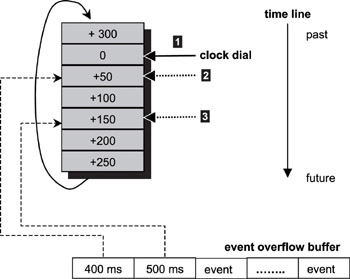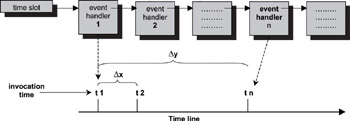Книга: Real-Time Concepts for Embedded Systems
11.6.1 Issues
11.6.1 Issues
A number of issues are associated with the timing wheel approach. The number of slots in the timing wheel has a limit, whatever that might be for the system. The example in Figure 11.13 makes this problem obvious. The maximum schedulable event is 350ms. How can a 400ms timer be scheduled? This issue causes an overflow condition in the timing wheel. One approach is to deny installation of timers outside the fixed range. A better solution is to accumulate the events causing the overflow condition in a temporary event buffer until the clock dial has turned enough so that these events become schedulable. This solution is illustrated in Figure 11.14.

Figure 11.14: Timing wheel overflow event buffer.
For example, in order to schedule a 400ms timeout when the clock dial is at location 1, this event must be saved in the event overflow buffer until the clock dial reaches location 2. To schedule a 500ms timer when clock dial is at location 1, this event must be saved in the event overflow buffer until the clock dial reaches location 3. The expired events at location 2 and location 3 must be serviced first, and then the new events installed. The event overflow buffer must be examined to see if new events need to be scheduled when the clock dial moves at each clock tick to the next slot. This process implies that the events in the overflow buffer must be sorted in increasing order. New events are inserted in order and can be expensive if the overflow buffer contains a large number of entries.
Another issue associated with the timing wheel approach is the precision of the installed timeouts. Consider the situation in which a 150ms timer event is being scheduled while the clock is ticking but before the tick announcement reaches the timing wheel. Should the timer event be added to the +150ms slot or placed in the +200ms slot? On average, the error is approximately half the size of the tick. In this example, the error is about 25ms.
One other important issue relates to the invocation time of the callbacks installed at each time slot. In theory, the callbacks should all be invoked at the same time at expiration, but in reality, this is impossible. The work performed by each callback is unknown; therefore, the execution length of each callback is unknown. Consequently, no guarantee or predictable measures exist concerning when a callback in a later position of the list can be called, even in a worst-case scenario. This issue introduces non-determinism into the system and is undesirable. Figure 11.15 illustrates the problem.

Figure 11.15: Unbounded soft-timer handler invocation.
Event handler 1 is invoked at t1 when the timeout has just expired. Similarly, event handler n is invoked at tn when the previous (n -1) event handlers have finished execution. The interval x and y is non-deterministic because the length of execution of each handler is unknown. These intervals are also unbounded.
Ideally, the timer facility could guarantee an upper bound; for example, regardless of the number of timers already installed in the system, event handler n is invoked no later than 200ms from the actual expiration time.
This problem is difficult, and the solution is application specific.
- Keeping Up-to-Date on Linux Security Issues
- 1.5. DESIGN ISSUES
- 2.4.5. Implementation Issues
- 2.5.2. Design Issues
- 4.1.3. Design Issues for Threads Packages
- 4.3.2. Design Issues for Processor Allocation Algorithms
- 4.3.3. Implementation Issues for Processor Allocation Algorithms
- 4.6.2. Design Issues
- Troubleshooting Build Issues
- Troubleshooting Thread Synchronization Issues
- Chapter 2. Issues of TCP
- Implementation ID




